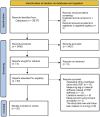A review of evidence on mechanical properties of running specific prostheses and their relationship with running performance
- PMID: 38962729
- PMCID: PMC11220186
- DOI: 10.3389/fresc.2024.1402114
A review of evidence on mechanical properties of running specific prostheses and their relationship with running performance
Abstract
Background: Although mechanical properties of running specific prostheses (RSPs) can affect running performance, manufacturers do not consistently report them. This study aimed to review existing literature on RSP mechanical and structural properties and their relationship with running performance.
Methods: A comprehensive search was conducted using keywords related to mechanical properties of RSPs and running performance. Search terms included stiffness and hysteresis, as well as performance outcomes including metabolic cost and running speed. Non-peer-reviewed and non-English publications were excluded.
Results: Twenty articles were included in the review. Sixteen studies used a material testing machine to measure RSP material properties, and four articles used other techniques including 2D/3D video capture and force platforms. Both measurement techniques and reporting of outcomes were inconsistent, which limits the ability to draw broad conclusions. Additionally, several studies did not report the numerical data for material properties despite measuring them. Relatively few articles measured both material properties and running performance and assessed correlations.
Conclusion: Several articles connected prosthesis properties to running performance. However, inconsistent measurement and reporting of mechanical properties, along with the multifactorial nature of the athlete-prosthesis system, limit the ability to draw broad conclusions regarding the relationship between material and structural properties and athlete performance. Current evidence may be useful for clinicians seeking ways to optimize RSP stiffness in a case-by-case basis; however, clinicians would benefit from more consistent and systematic comparisons of the attributes of different RSPs and their role in performance.
Keywords: mechanical properties; performance; prostheses; running; stiffness.
© 2024 Rahnama, Soulis and Geil.
Conflict of interest statement
The authors declare that the research was conducted in the absence of any commercial or financial relationships that could be construed as a potential conflict of interest.
Figures
Similar articles
-
Amputee locomotion: determining the inertial properties of running-specific prostheses.Arch Phys Med Rehabil. 2013 Sep;94(9):1776-83. doi: 10.1016/j.apmr.2013.03.010. Epub 2013 Mar 28. Arch Phys Med Rehabil. 2013. PMID: 23542403 Free PMC article.
-
'It's more than just a running leg': a qualitative study of running-specific prosthesis use by children and youth with lower limb absence.Disabil Rehabil. 2022 Nov;44(23):7190-7198. doi: 10.1080/09638288.2021.1986748. Epub 2021 Oct 19. Disabil Rehabil. 2022. PMID: 34665069
-
Prosthetic shape, but not stiffness or height, affects the maximum speed of sprinters with bilateral transtibial amputations.PLoS One. 2020 Feb 20;15(2):e0229035. doi: 10.1371/journal.pone.0229035. eCollection 2020. PLoS One. 2020. Retraction in: PLoS One. 2022 Dec 30;17(12):e0280174. doi: 10.1371/journal.pone.0280174. PMID: 32078639 Free PMC article. Retracted.
-
Match Running Performance in Young Soccer Players: A Systematic Review.Sports Med. 2019 Feb;49(2):289-318. doi: 10.1007/s40279-018-01048-8. Sports Med. 2019. PMID: 30671900
-
Metabolic Cost and Performance of Athletes With Lower Limb Amputation and Nonamputee Matched Controls During Running: A Systematic Review.Am J Phys Med Rehabil. 2022 Jun 1;101(6):584-589. doi: 10.1097/PHM.0000000000001874. Epub 2021 Sep 3. Am J Phys Med Rehabil. 2022. PMID: 34483259
References
Publication types
LinkOut - more resources
Full Text Sources


